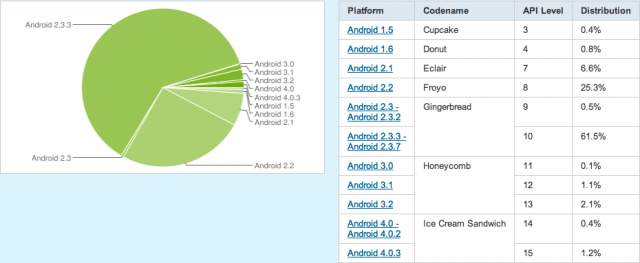
The Android Platform Distribution Chart could be called the Fragmentation Chart because it merely outlines how ridiculously divided we are between theory and reality in the Android world. Though Android 4.0 Ice Cream Sandwich was announced last October, and the first retail product to ship with it, the Galaxy Nexus, was released in December, we are still sitting at 1.6% of total devices. And there are a lot of devices.
But at this year’s Mobile World Congress, a showcase for the biggest device launches of the coming year, the vast majority of Androids were shown off running Gingerbread, an OS that was launched in December 2010. Sure, we’ve heard all the stories: OEMs only get the code when we see it, and it takes them ages to optimize it for their specific hardware. But we’re entering March with no clear view in sight of when devices will launch en masse with Ice Cream Sandwich.
But that’s a rant for another day. Google has released the latest version numbers for Android distribution, and Gingerbread is sitting pretty with 62% of the tally, with Froyo a distant second at 25.3%. Honeycomb seems stationary, sitting at a stable 3.3%, and should only shrink from now as most tablets are launching (thankfully) with ICS.
The newest version of Android, Ice Cream Sandwich, has 1.6% of total market share, but the vast majority of those users are running Android 4.0.3. This is significant because only software built from the Android Open Source Project — namely custom ROMs such as CyanogenMOD and MIUI — are natively running that version. The GSM version of the Galaxy Nexus is running Android 4.0.1 or 4.0.2, while the Verizon version has been upgraded to 4.0.4. The build that was briefly distributed for the Nexus S ran 4.0.3, but the rollout was stopped after a few days and hasn’t resumed. *Update: While the good point was made that tablets such as the Asus Transformer Prime were updated to version 4.0.3, if Honeycomb version totals are anything to go by, the number of tablets running ICS is statistically insignificant compared to the potential number of phones not running ICS.
Compared to last month, Gingerbread is up by 3.4%, Froyo is down by 2.5% and Ice Cream Sandwich is up by 0.6%. Not a bad month, all told.
Though we can’t know for sure how many devices Google is tracking (they measure devices who launch the Android Market between given times), it’s interesting to speculate how many of those are running custom ROMs — certainly over a million — but it’s no longer just a small subset of users, that’s for sure.
Source: Android Developers Blog
MobileSyrup may earn a commission from purchases made via our links, which helps fund the journalism we provide free on our website. These links do not influence our editorial content. Support us here.


